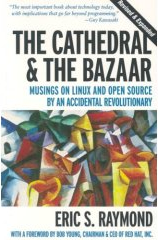07.05.07
“The Cathedral and the Bazaar”
 There’s a long tradition of great titles in the software engineering world. Djikstra’s “Goto Considered Harmful” has spawned thousands of imitators, and even a meta-paper. Fred Brook’s The Mythical Man-Month clicks as soon as you understand the title. Eric S. Raymond’s “The Cathedral and the Bazaar” gives open source software its defining image.
There’s a long tradition of great titles in the software engineering world. Djikstra’s “Goto Considered Harmful” has spawned thousands of imitators, and even a meta-paper. Fred Brook’s The Mythical Man-Month clicks as soon as you understand the title. Eric S. Raymond’s “The Cathedral and the Bazaar” gives open source software its defining image.
I read “The Cathedral and the Bazaar” as an introduction to the world of open source software for someone interested in joining it. There’s a history lesson to explain where you’ve come from and what you’ve accomplished. There’s arguments and a case study to show that you’re on the right ship. And finally, the essay serves as a call to arms, to get you excited about becoming a contributor.
I found the history lesson most interesting. I’d had some understanding of this before, but lacked much detail. ESR gives a first-person account of UNIX and software development from the late 1970′s to the present. This is the canonical story of open source. It has its heroes and villains, its true believers and false idols. There’s the Moses figure, Richard Stallman, who freed the users of UNIX from the oppressive yoke of restrictive licenses. But like Moses, he couldn’t enter the promise land. Open source stagnated, awaiting its Last True Prophet. This was Linus Torvalds, who created the Linux kernel, the last piece of the open source operating system.
ESR really uses that of tone. I get the sense that he’s intimidated by Richard Stallman and absolutely idolizes Linus Torvalds. The essay drips with hero worship. Linus is the visionary whose vision he’s writing about.
Beyond the hero worship, there is a clear exposition of the open source model. In order to avoid the problem of N^2 channels of communication amongst N contributors, open-source project have a small set of core developers. These core developers have total control over the project. They decide what gets checked in, and where the project goes. It’s a (hopefully) benevolent oligarchy. Outside of that core, there are occasional contributors and legions of testers, who can submit bug reports. Does this strict hierarchy really sound like a Bazaar?
If you want a real Bazaar, think about Wikipedia. Since I’ve never contributed to an open source project, I kept it in mind as a reference point. It works pretty well, but this perspective has the side effect of making open source development look positively Cathedral-like. Think about it. Rather than having a core set of contributors and legions of users/testers, Wikipedia explicitly aims to make all of its users into contributors. It does this by lowering the barriers to entry as low as it conceivably can, even if this leads to vandalism. All that’s needed to contribute is the ability to write in some language. Last time I checked, English had a few more speakers than C++. Rather than just reporting problems, users are empowered to fix them on the spot. See a typo? Just correct it. Want a citation? Find one and plop it in to help future readers.
I enjoyed “The Cathedral and the Bazaar” for the history lesson, but I find its central image misleading. The development process of open-source projects is as well-organized as any commercial venture.